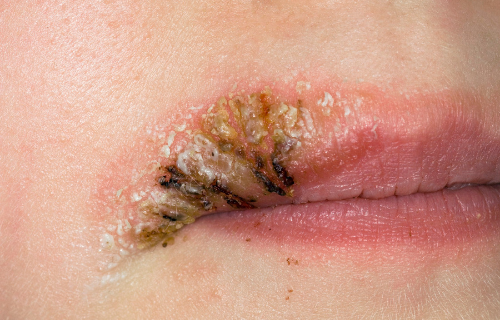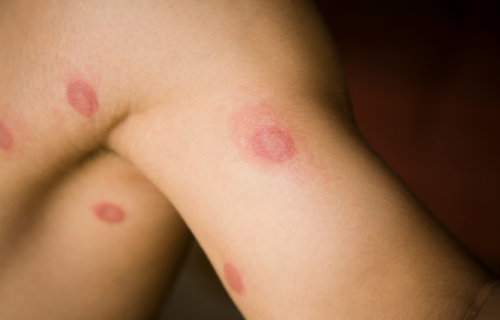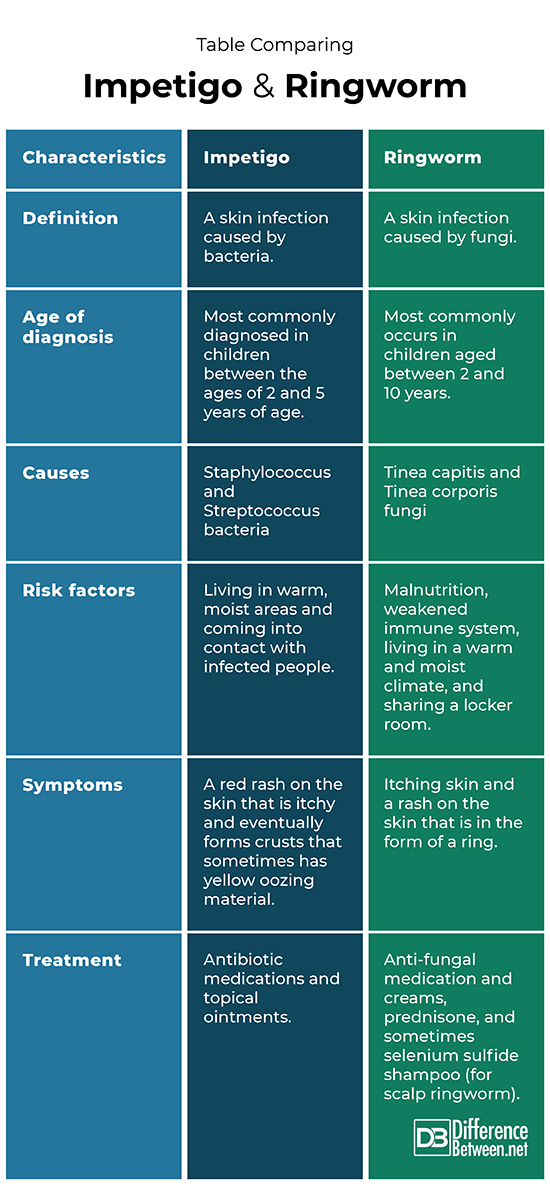Difference Between Impetigo and Ringworm
Impetigo is a skin infection that is due to infection by bacteria. Ringworm is a skin infection caused by Tinea fungus.

What is Impetigo?
Definition:
Impetigo is a bacterial infection of the skin that causes red, itchy sores to form.
Causes and risk factors:
The cause of impetigo is Staphylococcus or Streptococcus bacteria. It occurs mostly in young children but can affect people of other ages. The risk factors for impetigo include living in a warm and moist place, having a cut on the skin, and coming into contact with people who are infected.
Diagnosis:
A clinical examination noting the appearance of the skin sores can be used for a tentative diagnosis. Skin cultures can also be done to identify and confirm the causative bacteria. It is especially important to do cultures to rule out MRSA if the antibiotics are not working to control the infection.
Symptoms and complications:
The main symptoms are red, itchy sores that eventually form a crust. In some cases, the crust also produces a pus or fluid. The impetigo sores most commonly appear on the arms, legs, and face of the affected person. Impetigo can be dangerous if left untreated because the bacteria may move deeper into the skin resulting in cellulitis, which can lead to tissue death and gangrene.
Treatment:
Oral and topical antibiotics can be used to treat impetigo. Studies have shown that the topical ointments of mupirocin and fusidic acid are often effective against impetigo. Oral antibiotics such as erythromycin, amoxycillin, and penicillin are also used for treating impetigo.

What is Ringworm?
Definition:
Ringworm is a skin infection that is caused by a type of fungal organism.
Causes and risk factors:
The cause of ringworm is a fungus in the genus Tinea. Tinea corporis causes ringworm on the body while T. capitis causes scalp ringworm. Ringworm is most prevalent among children up to age 10, however, athletes of any age can become infected. Poor hygiene, malnutrition, weakened immune system, and living in warm, moist conditions are risk factors. Shared locker rooms also increases the risk of catching ringworm from other people.
Diagnosis:
A physical exam in which a doctor notes the ring-like appearance of the rash can indicate ringworm. Positive confirmation can be obtained by examining a sample of skin under the microscope on a slide. Potassium hydroxide is used to isolate any fungal cells from skin cells in the sample.
Symptoms and complications:
The typical symptoms include an itchy rash, which develops on the scalp or body and it appears in a ring-shape with normal tissue in the middle of the ring. The rash is limited to the scalp, groin, or feet. The skin can also appear crusty and in the case of scalp ringworm, there may be some hair loss. Left untreated, there can be complications of ringworm such as scarring and hair loss (when the scalp is affected).
Treatment:
Treatment for the scalp includes using shampoo containing selenium sulfide. Oral antifungals like terbinafine may be used and anti-fungal creams may be prescribed. Anti-fungal creams that can be used to treat ringworm include imidazole and ciclopirox.
Difference between Impetigo and Ringworm
Definition
Impetigo is a bacterial infection of the skin. Ringworm is a fungal infection of the skin that is seen as a red ring on the skin.
Age of diagnosis
The age group mostly diagnosed with impetigo are children between 2 and 5. Any age group can be affected by ringworm but the most frequently diagnosed is children ages between 2 and 10.
Causes
Staphylococcus and Streptococcus bacteria cause impetigo. Tinea capitis and Tinea corporis fungi cause ringworm.
Risk factors
Risk factors for impetigo include living in warm, moist areas and coming into contact with infected people. Risk factors for ringworm include malnutrition, having a weakened immune system, living in a warm, moist climate, and sharing a locker room.
Symptoms
Impetigo symptoms include a red, itchy rash that crusts over. Ringworm symptoms include itchy skin with a ring-shaped rash developing.
Treatment
Treatment of impetigo includes the use of antibiotic ointments and medicine like penicillin or erythromycin. Treatment of ringworm includes using oral antifungals and antifungal creams, and sometimes also prednisone.
Table comparing Impetigo and Ringworm

Summary of Impetigo Vs. Ringworm
- Impetigo and ringworm are both skin infections that can be confused when they first begin.
- Impetigo is caused by bacteria and forms discrete sores on the skin that eventually scab over.
- Ringworm is caused by fungi and it results in ring-shaped lesions that have normal skin in the center.
- Antibiotics treat impetigo while antifungals treat ringworm.
FAQ
Can impetigo look like ringworm?
It can look similar to ringworm when impetigo first begins. However, a clear and distinctive ring-shaped lesion is not formed in the case of impetigo.
What looks similar to impetigo?
In the early stages ringworm can resemble impetigo. Other skin infections such as cellulitis and even scabies infections can appear to be impetigo.
Is impetigo bacterial or fungal?
Impetigo is a bacterial infection of the skin caused by certain Streptococcus or Staphylococcus species.
Is impetigo always itchy?
Impetigo is always itchy with red skin scores occurring that later crust over and become yellowish.
- Difference Between Rumination and Regurgitation - June 13, 2024
- Difference Between Pyelectasis and Hydronephrosis - June 4, 2024
- Difference Between Cellulitis and Erysipelas - June 1, 2024
Search DifferenceBetween.net :
Leave a Response
References :
[0]Aaron, Denise M. “Tinea Corporis (Body Ringworm)”. Merck Manual, 2021, https://www.msdmanuals.com/professional/dermatologic-disorders/fungal-skin-infections/tinea-corporis-body-ringworm
[1]Koning, Sander, et al. "Interventions for impetigo." Cochrane Database of Systematic Reviews 1 (2012).
[2]Rehmus, Wingfield E. “Impetigo and Ecthyma”. Merck Manual, 2021, https://www.msdmanuals.com/professional/dermatologic-disorders/bacterial-skin-infections/impetigo-and-ecthyma
[3]Image credit: https://www.canva.com/photos/MADmTLDTDBI-editorial-use-only-impetigo-on-the-lip-if-a-6-year-old-female-/
[4]Image credit: https://www.canva.com/design/DAEy5jSMOWc/uAKiLL0_l-VKjn0QH0qAug/edit?ui=eyJEIjp7IkIiOiJNQUVFdkZENGNDOCJ9fQ
